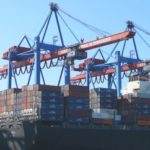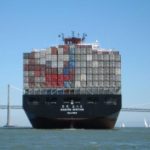Know how to stow with RSCS+

Optimization is an open-ended story: In the case of route-specific container stowage (RSCS), this applies especially to the parameters of flexibility, cost and time. On its cloud-based platform Veracity, DNV GL now offers its customers the new software app RSCS+ which allows them to calculate route and ship-specific stowage and loads in a simple and cost-effective way within the scope of the revised class notation Route Specific Container Stowage Plus.
Individualized route calculations as a service
Before the RSCS class notation was first introduced in 2013, shipbuilding and lashing rules were always based on a reference route in the North Atlantic only. However, the wind and wave conditions prevailing in that region are often much more severe than in other trading areas. Therefore new safety tolerances were defined for ten standard routes to allow containership operators to transport additional or heavier cargo on deck in those trading areas.
“We also began offering our customers individualized route calculations as a service. However, the entire process turned out to be too cumbersome,” recalls Daniel Abt, Senior Approval Engineer at DNV GL. “In view of the fact that container ships are increasingly being deployed on varying trades with varying load assumptions at shorter intervals, the newly developed ‘Plus’ version of the RSCS class notation offers true added value to our customers.”
With the new application, individual route calculations can be performed quickly and easily with a few mouse clicks. The operator simply clicks through the app, enters the route-specific information, such as ports and sea regions, and then receives the so-called Route Reduction Factor. This factor is then entered into the lashing computer to calculate the load. No further approval is required.
“The calculations for long-haul routes are based on the same, recognized DNV GL rules as before; the main difference is that digitalization has made the service much simpler and more flexible for our customers to define their own trading routes,” says Abt.
An advantage for short trips with RSCS+
The RSCS+ notation also ensures greater flexibility for stowing containers for limited short sea voyages. For example, when a vessel arrives at its first destination port in Europe after a longleg voyage from Asia and begins its so-called collecting trip, its partial draught changes from port to port, often requiring costly, time-consuming container re-stowage. The reason: When the vessel is partially loaded, its metacentric height (GM) rises, causing the ship to be stiffer in the water, and accelerations to increase. Its faster and harder rolling motion raises the loads acting upon the container stacks, which results in a container stack which had been safe now exceeding the permissible lashing forces.

Good weather conditions may avoid cost-intensive restowing after partial unloading of containers for short sea voyages.
“Repeated re-stowage is a significant cost factor for ship operators,” confirms Abt. “But when the sea is calm, it may not be necessary.” The new RSCS+ notation accounts for this scenario by enabling a weather-dependent lashing approach. On short legs of up to three days between two ports, applying reduced loads is feasible under calm weather conditions. This means that before leaving port, the operator must evaluate the maximum significant wave height expected during the next five days using data from reliable weather services. “In the event of delays or waiting time on the short voyage, this leaves a forty-eight-hour minimum safety buffer to the intended three-day voyage,” Abt explains.
The reduction factor solely depends on the forecasted significant wave height. In this scenario all calculations are performed on board, not online. “Nevertheless, the conditions during the limited short sea trip can be documented in a simple and clean manner using a template and the calculation is run with verified software,” says Abt.
Source: DNV GL Maritime Impact (https://www.dnvgl.com/expert-story/maritime-impact/Know-how-to-stow-with-RSCS.html)

 Hellenic Shipping News Worldwide Hellenic Shipping News Worldwide, Online Daily Newspaper on Hellenic and International Shipping
Hellenic Shipping News Worldwide Hellenic Shipping News Worldwide, Online Daily Newspaper on Hellenic and International Shipping























 PG-Software
PG-Software